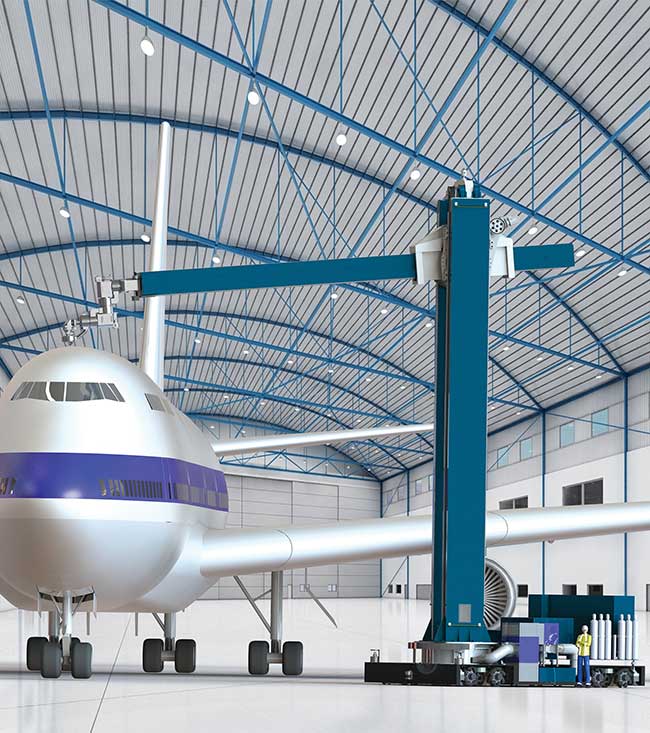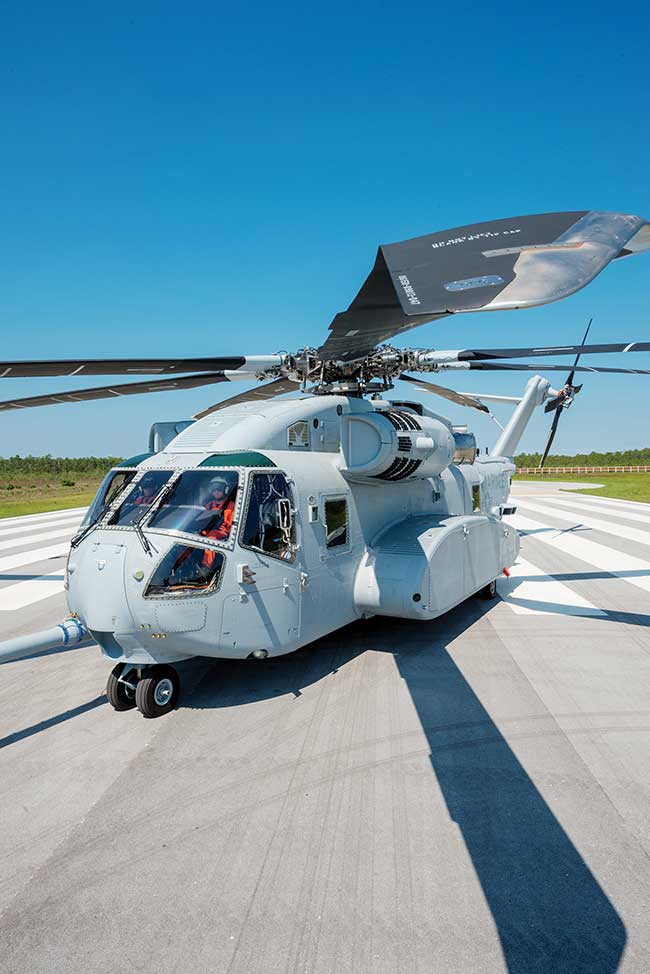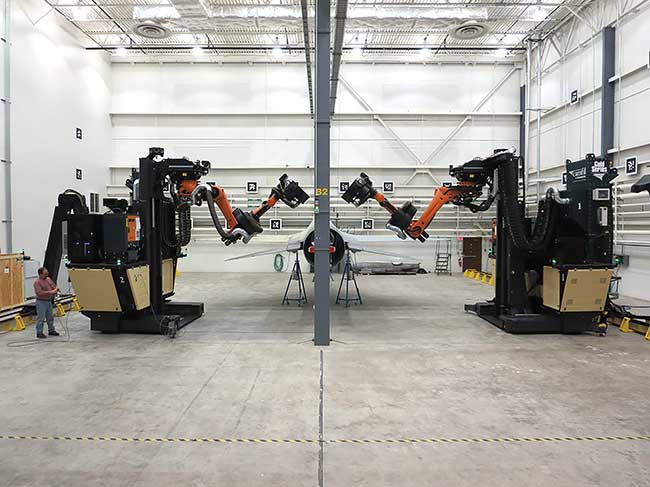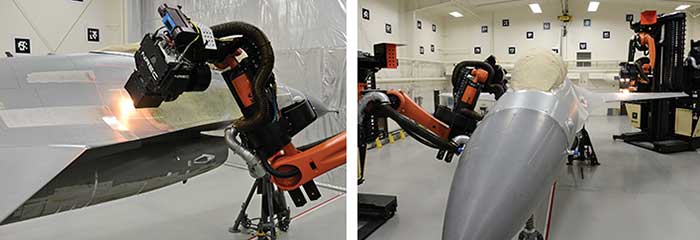At 52 feet tall, over 100,000 pounds and with a reach of 85 feet, LR Systems’ laser ablation mobile robot is one of the largest — if not the largest — mobile robots in the world. This summer, the company, based in the Netherlands, plans to install a laser coating removal robot (LCR) at the maintenance facility of a yet-to-be-announced large airline (Figure 1). The LCR, which features a newly designed 20-kW CO2 laser, will be the first full-aircraft, robotic laser stripping solution to be deployed by a commercial air carrier. The robot’s deployment will represent a milestone in the decades-long effort, largely driven by the U.S. military, to replace costly and environmentally harmful aerospace paint stripping methods, such as solvents, abrasives and blasting, with laser ablation. When mounted to the robot, the laser will be able to deliver a precisely aligned beam over 30 meters to remove microns of paint.

Figure 1. A rendering of LR Systems’ largest laser coating removal (LCR) system for commercial airliners. Courtesy of LR Systems.
“It is really many factors coming together, including advancements in robotics, lower cost and higher performing lasers, a greater emphasis on the sustainability and health benefits of the process, and private investment,” said Clay Flannigan, the assistant director of robotics and automation engineering at Southwest Research Institute (SwRI) in San Antonio, Texas. “To date, the U.S. Department of Defense has funded most of the process development and we are just now starting to see the commercialization of the technologies.”
Despite its Dutch roots, the LCR is the fruit of a collaborative with partners on both sides of the Atlantic. SwRI is the project’s prime contractor for the robot’s development, including a high-speed machine vision system for real-time control of laser power for selective stripping of paint layers. The Edison Welding Institute in Columbus, Ohio, provided a polygon laser scanner, which will focus and sweep the laser across the aircraft’s surface. The CO2 laser was developed by Trumpf Nederland in the Netherlands. LR Systems also has partnered with the Netherlands’ National Aerospace Laboratory and the Dutch Aerospace Lab for assistance in the qualification process with the U.S. Federal Aviation Administration and the European Aviation Safety Agency.
LR Systems’ website identifies Singapore Airlines as a first potential customer. The airline’s subsidiary, the Singapore Airlines Engineering Company, has entered into a memorandum of understanding with the Dutch company to provide support through the OEM qualification and certification process.
De-painting basics
Along with adding color to an aircraft, paint adds weight. For example, Airbus’ double-deck, wide-body, four-engine jet airliner A380, which features a 4,400-square-meter exterior surface, requires three layers of paint that weigh a total of approximately 500 kg1. Paint can either enhance marketing for commercial airlines through the use of company colors and logos or create strategic advantage for military jets in the form of camouflage designs. Simply painting on top of an old layer of paint that has begun to show wear could make the plane look new but at the expense of added weight.
“Each five or six years an aircraft is stripped and painted again to support repair of damages on the surface … and redo the paint to shield the aircraft from corrosion as paint needs to be replaced,” said Peter Boeijink, LR Systems’ program director.
Traditionally, de-painting has been done with chemical paint strippers, water picks, dry media blasting and hand sanding. In 2007, for example, to strip large parts of Boeing KC-135 air tankers that are usually removed during depot maintenance, U.S. Air Force personnel at Tinker Air Force Base in Oklahoma City used 4,360 gallons of chemical paint removal and 2.7 million gallons of rinse water that became contaminated during the de-painting process2. Since the early 1990s, the Air Force has been exploring alternative de-painting methods3. That search became more pressing with the enactment of federal legislation such as the Clean Water Act, Clean Air Act and Resource Conservation and Recovery Act, which put restrictions on the discharging of wastewater with hazardous waste, the emission of hazardous air pollutants and the disposal of de-painting-related waste, respectively.
For every one pound of de-paint, about four pounds of solid waste are produced through media blasting, and nine pounds of solid waste — plus 165 pounds of liquid waste — are created through the use of solvents. But with laser paint stripping, only about a half pound of solid waste results, according to defense contractor General Lasertronics, of San Jose, Calif., whose installed laser-based Automated Rotor Blade Stripping System (ARBSS) is used to remove coatings from Navy helicopter rotor blades (Figure 2).

Figure 2. General Lasertronics uses an Nd:YAG laser to remove coatings from CH-53 heavy-lift transport helicopters. Courtesy of Sikorsky.
Laser demand
When Lasertronics launched its first paint stripping system in the mid-1990s, it did so with a CO2 laser. The company used this technology until about 2000, when it was replaced with an Nd:YAG laser from Northrop Grumman’s Cutting Edge Optronics in St. Charles, Mo. Jim Russell, Lasertronics’ director of business development, said the Nd:YAG’s flexible fiber optic beam delivery system enables “access to nooks and crannies on aircraft,” such as internal wing fuel tanks. Although the company’s customers were pleased with the Nd:YAG, they were less so with the downtime the technology required and its frequent need for costly maintenance. Consequently, Lasertronics in 2014 started using fiber lasers from IPG Photonics in Oxford, Mass.
“The IPG fiber laser has proven to be extremely robust and operator-friendly. As laser prices continue to fall, we envision many coating removal jobs, across industries, being taken over by laser ablation systems,” said Russell.
The bubbling aerospace laser ablation market has not gone unnoticed at IPG. In an April 2015 conference call, IPG Chairman and CEO Valentin Gapontsev noted the receipt of “high volume requests for efficient paint removal systems for aircraft and ships.” He added that the company’s long-term project for this application was “turning from qualification to the mass deployment phase, and IPG fiber lasers are playing the role of an excellent engine there.” Last February he said during a conference call that laser cleaning, including in aerospace, was a growth area for IPG. He added that the company’s “unique multi-kilowatt nanosecond fiber lasers are starting to change the situation in this large market segment.”
Lasertronics was not alone in transitioning away from CO2 lasers for robotic paint removal systems. Concurrent Technologies Corp., which is based in Johnstown, Penn.,. also utilizes IPG fiber lasers for its Advanced Robotic Laser Coating Removal Systems (ARLCRSs), which are used by the U.S. Air Force. LR Systems, however, still uses CO2 lasers. In fact, its CO2 laser by Trumpf is believed to be the largest of its kind for laser ablation for its robotic system. Flannigan at the Southwest Research Institute said this laser is especially good at removing difficult coatings, such as clear coats and the white top coats that are prevalent on commercial airliners.
“White paints tend to be highly reflective and low solids paints, such as clear coats and primers, tend to be highly transmissive. Both of these phenomena have [a] negative impact on stripping efficiency and substrate temperatures. CO2 wavelengths, 10.6 microns, are well absorbed by most paints, and thus, more energy goes into ablating the paint than heating the substrate or environment,” Flannigan said.
While pulsed lasers’ high peak power help them overcome the limitations imposed by continuous lasers’ shorter wavelength, Flannigan said paint stripping rate is approximately proportional to average laser power. That makes it difficult to safely deliver a high average power pulsed laser without locally overheating the substrate.
“The issue with the CO2 lasers is that the beam needs to be manipulated around the aircraft using mirrors, and those mirrors need to maintain alignment with each other — a very difficult task. In addition, the cost of operating and maintaining a fiber is significantly less than a CO2 system,” said Tom Nugay, deputy technical director for the Air Force Materiel Command’s Logistics, Civil Engineering and Force Protection Directorate at Wright-Patterson Air Force Base in Ohio.
Military advances: jets
Recent years have seen laser de-painting make significant gains at U.S. air bases, particularly since the 2008 demonstration of a Robotic Laser Coating Removal System (RLCRS) on KC-135 parts at Tinker Air Force Base. The RLCRS was the one of a series of robotic systems developed by Concurrent for the Air Force, and a year later the company built and installed a Laser Automated De-painting System II (LADS II) at Hill Air Force Base in Utah. The Air Force used this railed robotic system with a Rofin-Sinar Technologies CO2 laser to strip General Dynamics’ F-16 fighter jets.
In June 2015, Concurrent and Carnegie Mellon University’s National Robotics Engineering Center in Pittsburgh developed and transferred to the Utah air base two ARLCRSs (Figure 3). Unlike the LADS II, the ARLCRSs are semi-autonomous and each robot features a fiber laser by IPG. Between the two systems, there are six robots, said Concurrent Principal Engineer Mary Bush, with two reserved for stripping F-16s and four for Lockheed Martin C-130 cargo planes. The ARLCRSs have reduced de-paint flow days by over 50 percent: from seven to three days for the F-16s and from 10 to five days for the C-130s, according to Nugay.

Figure 3. Two Advanced Robotic Laser Coating Removal Systems (ARLCRSs), developed by Concurrent Technologies Corp. and the National Robotics Engineering Center, are used to strip paint from F-16 fighter jets. Courtesy of Concurrent Technologies.
“The ARLCRS … is the only semi-autonomous robotic laser system that has been developed, constructed and implemented. The technology is applicable to commercial airlines and other aerospace industries,” Bush said.
ARLCRS regular production recently began on Hill Air Force Base’s F-16s and is expected to begin on the base’s C-130s during the first quarter of 2017 (Figure 4). The Air Force also plans to build next-generation ARLCRSs at Robins Air Force base in Georgia during the 2017 fiscal year. Nugay said that depending on the size of the aircraft, the systems cost between $5 million and $7 million.

Figure 4. An Advanced Robotic Laser Coating System removes coatings to the primer layer of an F-16 at Hill Air Force Base, Utah. Courtesy of U.S. Air Force, photos by Alex R. Lloyd.
“We believe that laser technology is very attractive for removing paint from composites, aluminum and steel materials used in the aerospace industry.” Nugay said. “In addition, for each F-16, we see a 99 percent reduction in total waste disposal and an elimination of 2,000 pounds of hazardous waste, no hazardous materials used, minimal personal protective equipment and a clean control room working environment. That is why we are pursuing [it].”
Military advances: helicopters
In 2009, Lasertronics also installed its Automated Rotor Blade Stripping Systems at Marine Corps Air Station Cherry Point in North Carolina, where it strips paint off the fiber glass composite rotors of Sikorsky CH-53E heavy-lift helicopters. The laser system has eliminated the amount of scrap from parts damaged during de-painting, which had run above 10 percent with manual rotary sanders — an important reduction given that each blade is about 38 feet long and costs about $120,000.
“This is a nondestructive technology,” said Ralph Miller, a Lasertronics co-founder and vice president of marketing communications.
Lasertronics is replacing the ARBSS’s Nd:YAG lasers by U.S. Laser Corp. of Wycoff, N.J., with 400-W ones made by Lee Laser Inc. in Orlando, Fla. After that upgrade is complete, Naval Air Systems Command plans extend the ARBSS program to the Boeing V-22 Osprey. Cherry Point’s Sikorsky H-60 Blackhawk blades are also being eyed for laser stripping, said Lasertonics’ Russell.
Rotor blades routinely need to be stripped both for blade repair and because touch-up paint unevenly applied in the field could result in balance problems, said Russell. Lasertronics is also exploring removing contact erosion guard coating from Boeing Apache rotor blades. A Lasertronics handheld laser system has also been used to remove sealant from a Fairchild Republic A-10 Thunderbolt’s center wing fuel tanks, where it demonstrated an ability to dramatically throughput time and cost.
On the horizon: commercial airliners
Despite these inroads, Russell said laser stripping’s growth in the military has been stunted by the automatic federal budget cuts, referred to as sequestration, first implemented on the U.S. Department of Defense in 2013. For Lasertronics, progress with commercial airlines has also been much slower than expected, especially after the company became the only laser de-painting company to receive FAA approval in 2010. While that agency’s blessing is important, Russell said maintenance, repair and overhaul providers generally have been reluctant to adopt laser stripping technology because it is not included in OEM service manuals.
“As soon as the manuals can get changed, a whole lot of things will happen quickly,” said Russell.
Commercial airliner interest
That is not to say commercial airliners have been reluctant to embrace laser ablation. Since the early 2000s, for example, Airbus has used lasers made by Adapt Laser Systems of Kansas City, Mo., to remove paint for electrical bonding contacts. Adapt already has approximately 30 lasers in use for aircraft paint removal tasks, including several fiber lasers for small-area paint removal on the F-16s and C-130s at Hill Air Force Base. In 2015, Lockheed Martin also approved an Adapt laser for the removal of coatings from areas for structural bonding of nutplates to metallic structures of F-35 multirole stealth fighters, according to Adapt Laser President Georg Heidelmann. He is “very optimistic” that lasers will be deployed in the near future for full-body de-painting of military and commercial aircraft.
At Boeing, Kay Blohowiak, a senior technical fellow in chemical technologies and adhesive bonding said the company “... continues to research new technologies to improve our manufacturing processes, including the use of lasers to replace chemicals, and manual sanding processes for removing coatings from aircraft structures, as well as for cleaning and preparing surfaces for painting, bonding and sealing. Transitioning laser ablation from laboratory coupon scale to manufacturing scale is the focus of ongoing research.”
References
1. British Airways, Fleet Facts: Airbus 380-800. http://www.britishairways.com/en-gb/information/about-ba/fleet-facts/airbus-380-800.
2. J. Arthur et al. (2008). Remote Laser Coating Removal System. Final Technical Report. http://www.dtic.mil/dtic/tr/fulltext/u2/a608206.pdf.
3. Department of Defense Office of the Inspector General (April 1993). Air Force Study on Paint Stripping Technology. http://www.dodig.mil/Audit/Audit2/93-086.pdf.
Vision Systems Send Paint Stripping Into High Speed
Needing to balance aesthetics with weight, aerospace manufacturers typically apply thin layers of paint to their aircraft. While planes coming out of the factory may have up to 5 mils of paint, that thickness can be up to 20 mils for aircraft that have long been in operation and subjected to touch-ups, according to Jim Russell, director of business development for General Lasertronics, a San Jose, Calif., defense contractor. To precisely strip these thin layers of paint from aircraft — sometimes stopping short of the primer and without damaging the underlying aluminum or composite material — robotic laser coating removal systems rely on a variety of optical and laser sensors.
However, not all robots see laser paint removal the same way because of the different high-speed vision systems they employ. Below are brief descriptions of the vision systems used in the Laser Coating Removal System (LCR) by LR Systems, the Automated Rotor Blade Stripping System (ARBSS) by General Lasertronics and the Advanced Robotic Laser Coating Removal System (ARLCRS) by Concurrent Technologies Corp. and the National Robotics Engineering Center.
LCR: The system monitors the estimated state of paint removal by using color and NIR imaging at a rate of 300 Hz. The vision system provides a laser power command with a resolution of several millimeters. Laser power is updated 20,000 times a second. The LCR “learns” what the desired paint looks like by using machine learning algorithms, according to Clay Flannigan, the assistant director of robotics and automation engineering at San Antonio, Texas-based Southwest Research Institute, which developed the LCR’s vision system.
ARBSS: The system evaluates the color of the work surface, with laser pulses being held in check until the presence of the coating to be removed is confirmed. This system selectively removes a top or sub-coat of paint and prevents the laser from ever directly striking the delicate fiberglass composite substrate, according to Russell.
ARLCRS: The system’s color cameras provide data for a surface property analyzer and a scanning lidar sensor collects 3D data for surface mapping1. The sensors detect and classify the state of de-painting, allowing the robot to modify its coverage plans and avoid stripped areas or target areas where coatings remain2.
To learn more about high-speed vision systems, see the April 2014 issue of Industrial Photonics for a technical feature article, “Vision Offers Control of a High-Power Laser Ablation Process,” by Michael Rigney, a staff engineer in SwRI’s Robotics and Automation Engineering Section. Go to www.photonics.com/A56086.